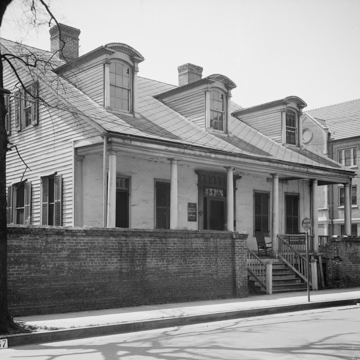Gallic and Anglo-American influences mingle artfully in the Portier House, Alabama’s best-known example of what is still popularly known as a Creole cottage. The term may be more picturesque than precise, though tradition has long rooted this distinctive Gulf Coast house-type in the French colonial period. Some see in it elements drawn from across France’s far-flung empire: the long, front galerie from the West Indies, the steep downward plunge of the sheltering roof from Upper Canada, with distant antecedents even in Normandy. Its superficial resemblance to a similar house type appearing on the Atlantic seaboard, especially in the Carolinas, may be purely coincidental or simply the result of inevitable cross-fertilization as two cultures came into contact.
A young seminarian-architect, Claude Beroujon, is credited with the design and construction of the Portier House, though some sources maintain that he actually renovated an existing structure. Facing onto a plaza where a Roman Catholic house of worship had stood since the eighteenth century, the house was intended to serve the clergy of the recently established Diocese of Mobile. Specifically, it was intended to be both office and rectory for Beroujon’s French-born uncle, Bishop Michael Portier. As Portier himself wrote at the time, it would provide diocesan priests with “an honorable residence and a handy one, without losing sight, however, of that evangelical simplicity which we preach.” As if to underscore his point, he added that the “house, which is composed of ten rooms, cost me . . . $7,000.”
A long galerie, fronted by slender turned colonnettes, shelters a smoothly plastered five-bay facade. Casement windows lend an additional Gallic touch. In contrast, the trio of handsome segmentally arched dormers that punctuate the roofline are filled with double-hung American sash windows. There are two main entries: the principal doorway, framed by leaded sidelights and transom, is set into an elegant neoclassical surround accented by a full Doric entablature, while a smaller door at the left end of the gallery gives access to what was originally the bishop’s office.
Inside, in a departure from the Creole tradition, a central hall leads to high-ceilinged rooms on either side. A relief plaster ceiling medallion in the hallway, like trim and woodwork throughout, is no doubt derived from popular builders’ handbooks of the day, such as those of Asher Benjamin and Owen Biddle. Apparently unique is the intriguing arrow motif worked into each baluster of the tightly winding stair at the back of the main hall. From there, a door opens onto the rear galerie and a courtyard-like service area where a large, two-story brick dependency stood as late as the 1930s. Here, too, were the original separate kitchen facilities typical of this subtropical environment.
While no longer a clerical residence, the Portier House is still owned by the Archdiocese of Mobile. In 2007, the Portier House underwent the most recent of three restorations, others having been carried out in 1957 and 1980. Today, the house is open to the public and available for private functions.
References
Gamble, Robert. The Alabama Catalog: Historic American Buildings Survey. A Guide to the Early Architecture of the State.Tuscaloosa: University of Alabama Press, 1986.
Gould, Elizabeth Barrett. From Fort to Port: An Architectural History of Mobile, Alabama, 1711–1918. Tuscaloosa: University of Alabama Press, 1988.
Sledge, John S. The Pillared City: Greek Revival Mobile.Athens: University of Georgia Press, 2009.














